remote control SKODA OCTAVIA TOUR 2009 1.G / (1U) Owner's Manual
[x] Cancel search | Manufacturer: SKODA, Model Year: 2009, Model line: OCTAVIA TOUR, Model: SKODA OCTAVIA TOUR 2009 1.G / (1U)Pages: 224, PDF Size: 13.53 MB
Page 4 of 224
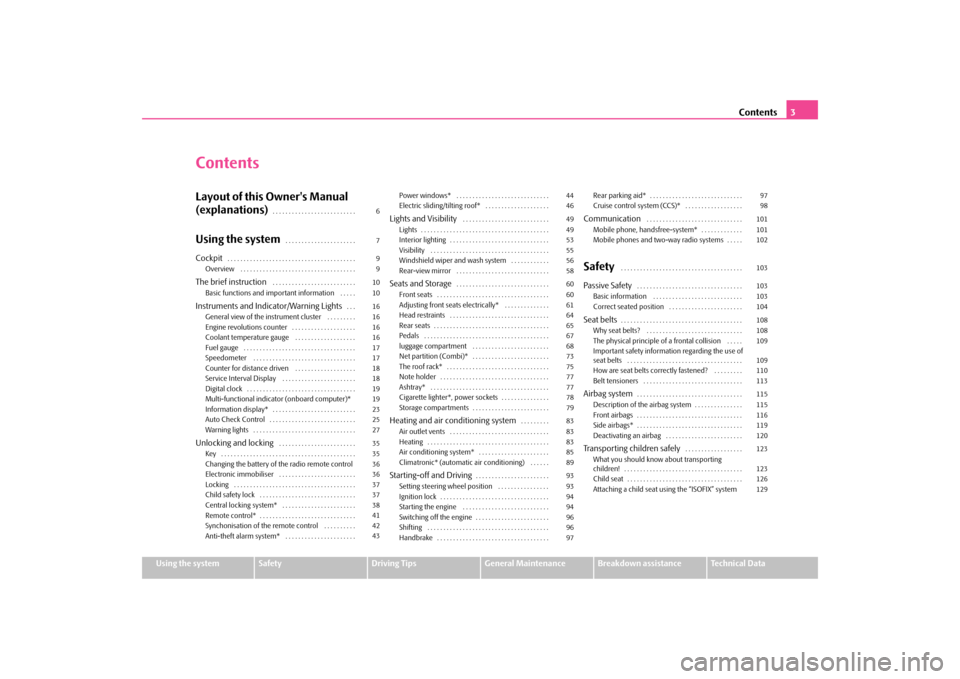
Contents
3
Using the system
Safety
Driving Tips
General Maintenance
Breakdown assistance
Technical Data
ContentsLayout of this Owner's Manual (explanations)
. . . . . . . . . . . . . . . . . . . . . . . . . .
Using the system
. . . . . . . . . . . . . . . . . . . . . .
Cockpit
. . . . . . . . . . . . . . . . . . . . . . . . . . . . . . . . . . . . . . . .
Overview . . . . . . . . . . . . . . . . . . . . . . . . . . . . . . . . . . . . The brief instruction
. . . . . . . . . . . . . . . . . . . . . . . . . .
Basic functions and important information . . . . . Instruments and Indicator/Warning Lights
. . .
General view of the instrument cluster . . . . . . . . . Engine revolutions counter . . . . . . . . . . . . . . . . . . . . Coolant temperature gauge . . . . . . . . . . . . . . . . . . . Fuel gauge . . . . . . . . . . . . . . . . . . . . . . . . . . . . . . . . . . . Speedometer . . . . . . . . . . . . . . . . . . . . . . . . . . . . . . . . Counter for distance driven . . . . . . . . . . . . . . . . . . . Service Interval Display . . . . . . . . . . . . . . . . . . . . . . . Digital clock . . . . . . . . . . . . . . . . . . . . . . . . . . . . . . . . . . Multi-functional indicator
(onboard computer)*
Information display* . . . . . . . . . . . . . . . . . . . . . . . . . . Auto Check Control . . . . . . . . . . . . . . . . . . . . . . . . . . . Warning lights . . . . . . . . . . . . . . . . . . . . . . . . . . . . . . . . Unlocking and locking
. . . . . . . . . . . . . . . . . . . . . . . .
Key . . . . . . . . . . . . . . . . . . . . . . . . . . . . . . . . . . . . . . . . . . Changing the battery of the radio remote controlElectronic immobiliser . . . . . . . . . . . . . . . . . . . . . . . . Locking . . . . . . . . . . . . . . . . . . . . . . . . . . . . . . . . . . . . . . Child safety lock . . . . . . . . . . . . . . . . . . . . . . . . . . . . . . Central locking system* . . . . . . . . . . . . . . . . . . . . . . . Remote control* . . . . . . . . . . . . . . . . . . . . . . . . . . . . . . Synchonisation of the remote control . . . . . . . . . . Anti-theft alarm system* . . . . . . . . . . . . . . . . . . . . . .
Power windows* . . . . . . . . . . . . . . . . . . . . . . . . . . . . . Electric sliding/tilting roof* . . . . . . . . . . . . . . . . . . . . Lights and Visibility
. . . . . . . . . . . . . . . . . . . . . . . . . . .
Lights . . . . . . . . . . . . . . . . . . . . . . . . . . . . . . . . . . . . . . . . Interior lighting . . . . . . . . . . . . . . . . . . . . . . . . . . . . . . . Visibility . . . . . . . . . . . . . . . . . . . . . . . . . . . . . . . . . . . . . Windshield wiper and wash system . . . . . . . . . . . . Rear-view mirror . . . . . . . . . . . . . . . . . . . . . . . . . . . . . Seats and Storage
. . . . . . . . . . . . . . . . . . . . . . . . . . . . .
Front seats . . . . . . . . . . . . . . . . . . . . . . . . . . . . . . . . . . . Adjusting front seats electrically* . . . . . . . . . . . . . . Head restraints . . . . . . . . . . . . . . . . . . . . . . . . . . . . . . . Rear seats . . . . . . . . . . . . . . . . . . . . . . . . . . . . . . . . . . . . Pedals . . . . . . . . . . . . . . . . . . . . . . . . . . . . . . . . . . . . . . . luggage compartment . . . . . . . . . . . . . . . . . . . . . . . . Net partition (Combi)* . . . . . . . . . . . . . . . . . . . . . . . . The roof rack* . . . . . . . . . . . . . . . . . . . . . . . . . . . . . . . . Note holder . . . . . . . . . . . . . . . . . . . . . . . . . . . . . . . . . . Ashtray* . . . . . . . . . . . . . . . . . . . . . . . . . . . . . . . . . . . . . Cigarette lighter*, power sockets . . . . . . . . . . . . . . . Storage compartments . . . . . . . . . . . . . . . . . . . . . . . . Heating and air conditioning system
. . . . . . . . .
Air outlet vents . . . . . . . . . . . . . . . . . . . . . . . . . . . . . . . Heating . . . . . . . . . . . . . . . . . . . . . . . . . . . . . . . . . . . . . . Air conditioning system* . . . . . . . . . . . . . . . . . . . . . . Climatronic* (automatic air conditioning) . . . . . . Starting-off and Driving
. . . . . . . . . . . . . . . . . . . . . . .
Setting steering wheel position . . . . . . . . . . . . . . . . Ignition lock . . . . . . . . . . . . . . . . . . . . . . . . . . . . . . . . . . Starting the engine . . . . . . . . . . . . . . . . . . . . . . . . . . . Switching off the engine . . . . . . . . . . . . . . . . . . . . . . . Shifting . . . . . . . . . . . . . . . . . . . . . . . . . . . . . . . . . . . . . . Handbrake . . . . . . . . . . . . . . . . . . . . . . . . . . . . . . . . . . .
Rear parking aid* . . . . . . . . . . . . . . . . . . . . . . . . . . . . . Cruise control system (CCS)* . . . . . . . . . . . . . . . . . . Communication
. . . . . . . . . . . . . . . . . . . . . . . . . . . . . .
Mobile phone, handsfree-system* . . . . . . . . . . . . . Mobile phones and two-way radio systems . . . . . Safety
. . . . . . . . . . . . . . . . . . . . . . . . . . . . . . . . . . . . . .
Passive Safety
. . . . . . . . . . . . . . . . . . . . . . . . . . . . . . . . .
Basic information . . . . . . . . . . . . . . . . . . . . . . . . . . . . Correct seated position . . . . . . . . . . . . . . . . . . . . . . . Seat belts
. . . . . . . . . . . . . . . . . . . . . . . . . . . . . . . . . . . . . .
Why seat belts? . . . . . . . . . . . . . . . . . . . . . . . . . . . . . . The physical principle of a frontal collision . . . . . Important safety information regarding the use of seat belts . . . . . . . . . . . . . . . . . . . . . . . . . . . . . . . . . . . . How are seat belts correctly fastened? . . . . . . . . . Belt tensioners . . . . . . . . . . . . . . . . . . . . . . . . . . . . . . . Airbag system
. . . . . . . . . . . . . . . . . . . . . . . . . . . . . . . . .
Description of the airbag system . . . . . . . . . . . . . . . Front airbags . . . . . . . . . . . . . . . . . . . . . . . . . . . . . . . . . Side airbags* . . . . . . . . . . . . . . . . . . . . . . . . . . . . . . . . . Deactivating an airbag . . . . . . . . . . . . . . . . . . . . . . . . Transporting children safely
. . . . . . . . . . . . . . . . . .
What you should know about transporting children! . . . . . . . . . . . . . . . . . . . . . . . . . . . . . . . . . . . . . Child seat . . . . . . . . . . . . . . . . . . . . . . . . . . . . . . . . . . . . Attaching a child seat using the “ISOFIX” system
6 7 9 9 10 10 16 16 1616171718181919232527 35 35 3636373738414243
44 46 49 49 53555658 60 60 6164656768737577777879 83 83 838589 93 93 9494969697
97 98 101 101 102 103 103 103 104 108 108 109 109 110113 115 115 116 119 120 123 123 126129
s2g8.b.book Page 3 Tuesday, April 7, 2009 8:53 AM
Page 11 of 224
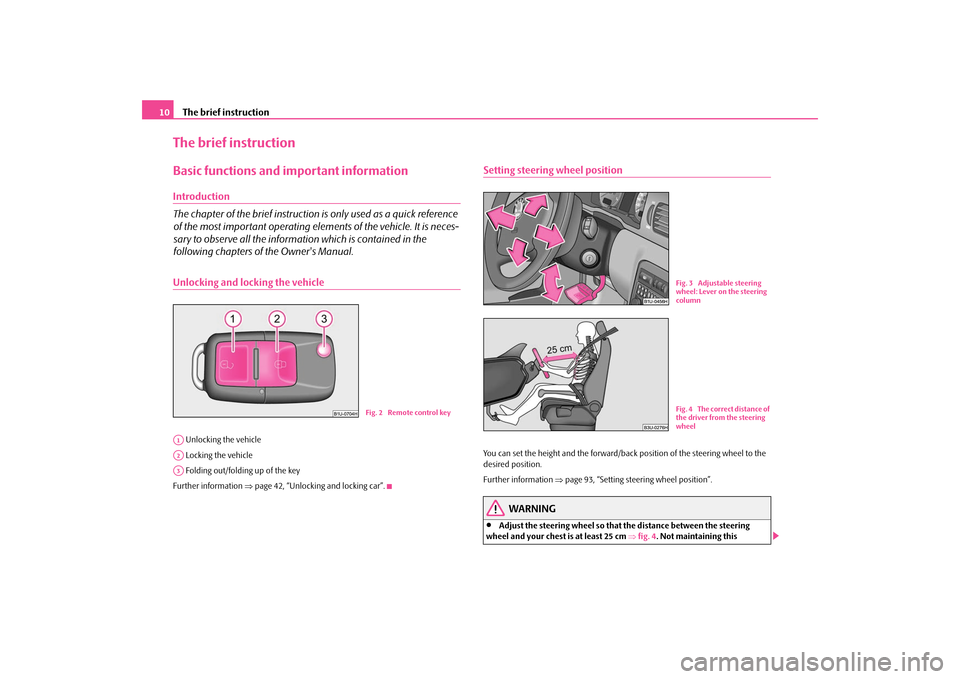
The brief instruction
10
The brief instructionBasic functions and important informationIntroduction The chapter of the brief instruction
is only used as a quick reference
of the most important operating elements of the vehicle. It is neces- sary to observe all the informat
ion which is contained in the
following chapters of the Owner's Manual.Unlocking and locking the vehicle Unlocking the vehicle Locking the vehicle Folding out/folding up of the keyFurther information
⇒page 42, “Unlocking and locking car”.
Setting steering wheel positionYou can set the height and the forward/back position of the steering wheel to the desired position. Further information
⇒page 93, “Setting steering wheel position”.
WARNING
•
Adjust the steering wheel so that
the distance between the steering
wheel and your chest is at least 25 cm
⇒fig. 4
. Not maintaining this
Fig. 2 Remote control key
A1A2A3
Fig. 3 Adjustable steering wheel: Lever on the steering columnFig. 4 The correct distance of the driver from the steering wheel
s2g8.b.book Page 10 Tuesday, April 7, 2009 8:53 AM
Page 36 of 224
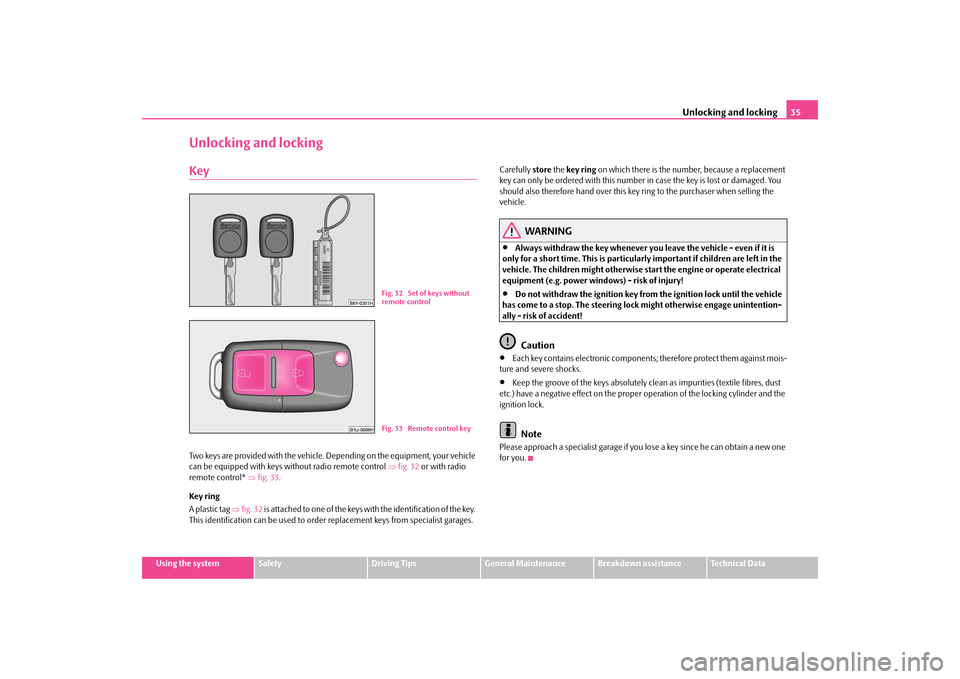
Unlocking and locking
35
Using the system
Safety
Driving Tips
General Maintenance
Breakdown assistance
Technical Data
Unlocking and lockingKeyTwo keys are provided with the vehicle.
Depending on the equi
pment, your vehicle
can be equipped with keys
without radio remote control
⇒fig. 32
or with radio
remote control*
⇒fig. 33
.
Key ring A plastic tag
⇒fig. 32
is attached to one of the keys with the identification of the key.
This identification can be
used to order replacement keys from specialist garages.
Carefully
store
the
key ring
on which there is the number, because a replacement
key can only be ordered with this number
in case the key is lost or damaged. You
should also therefore hand over this ke
y ring to the purchaser when selling the
vehicle.
WARNING
•
Always withdraw the key
whenever you leave the ve
hicle - even if it is
only for a short time. This is particularly important if children are left in the vehicle. The children migh
t otherwise start the engine
or operate electrical
equipment (e.g. power windows) - risk of injury!•
Do not withdraw the ignition key from the ignition lock until the vehicle
has come to a stop. The steering lock
might otherwise engage unintention-
ally - risk of accident!
Caution
•
Each key contains electronic components
; therefore protect them against mois-
ture and severe shocks.•
Keep the groove of the keys absolutely clean as impurities (textile fibres, dust
etc.) have a negative effect on the proper operation of the locking cylinder and the ignition lock.
Note
Please approach a specialist garage if you lose a key since he can obtain a new one for you.
Fig. 32 Set of keys without remote controlFig. 33 Remote control key
s2g8.b.book Page 35 Tuesday, April 7, 2009 8:53 AM
Page 37 of 224
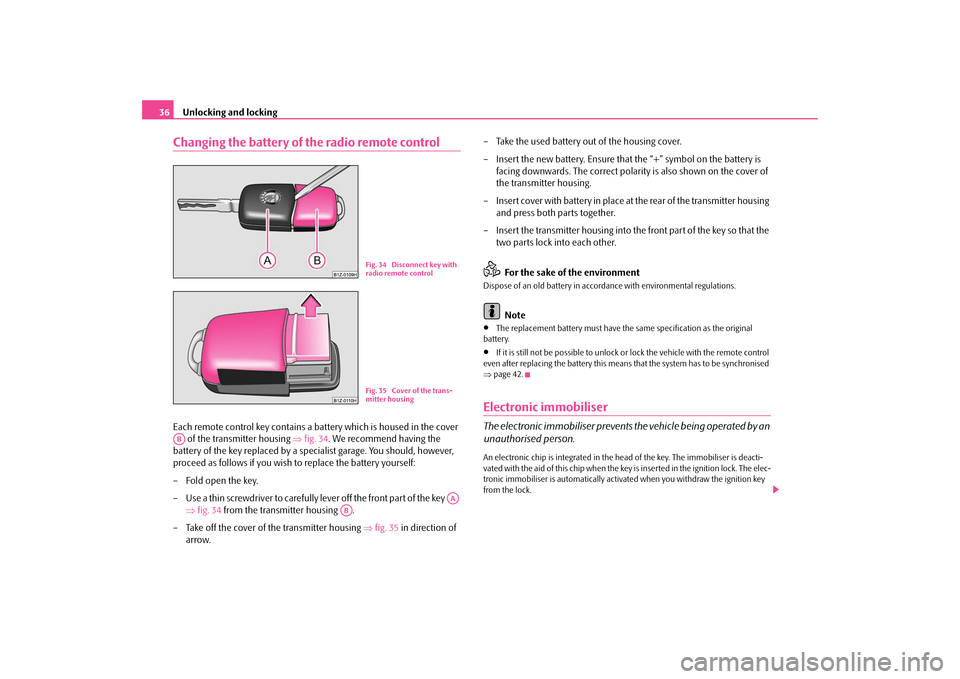
Unlocking and locking
36
Changing the battery of the radio remote controlEach remote control key contains a battery which is housed in the cover
of the transmitter housing
⇒
fig. 34
. We recommend having the
battery of the key replaced by a spec
ialist garage. You should, however,
proceed as follows if you wish
to replace the battery yourself:
– Fold open the key. – Use a thin screwdriver to carefully lever off the front part of the key
⇒
fig. 34
from the transmitter housing .
– Take off the cover of the transmitter housing
⇒
fig. 35
in direction of
arrow.
– Take the used battery out of the housing cover. – Insert the new battery. Ensure that the “+” symbol on the battery is
facing downwards. The correct polarity is also shown on the cover of the transmitter housing.
– Insert cover with battery in place at
the rear of the transmitter housing
and press both parts together.
– Insert the transmitter housing into the front part of the key so that the
two parts lock into each other. For the sake of the environment
Dispose of an old battery in accord
ance with environmental regulations.
Note
•
The replacement battery must have the same specification as the original
battery.•
If it is still not be possib
le to unlock or lock the ve
hicle with the remote control
even after replacing the battery this means that the system has to be synchronised ⇒ page 42.Electronic immobiliserThe electronic immobiliser prevents
the vehicle being operated by an
unauthorised person.An electronic chip is integrated in the he
ad of the key. The i
mmobiliser is deacti-
vated with the aid of this chip when the key is inser ted in the ignition lock. The elec-tronic immobiliser is automatically activa
ted when you withdraw the ignition key
from the lock.
Fig. 34 Disconnect key with radio remote controlFig. 35 Cover of the trans-mitter housing
AB
AA
AB
s2g8.b.book Page 36 Tuesday, April 7, 2009 8:53 AM
Page 39 of 224
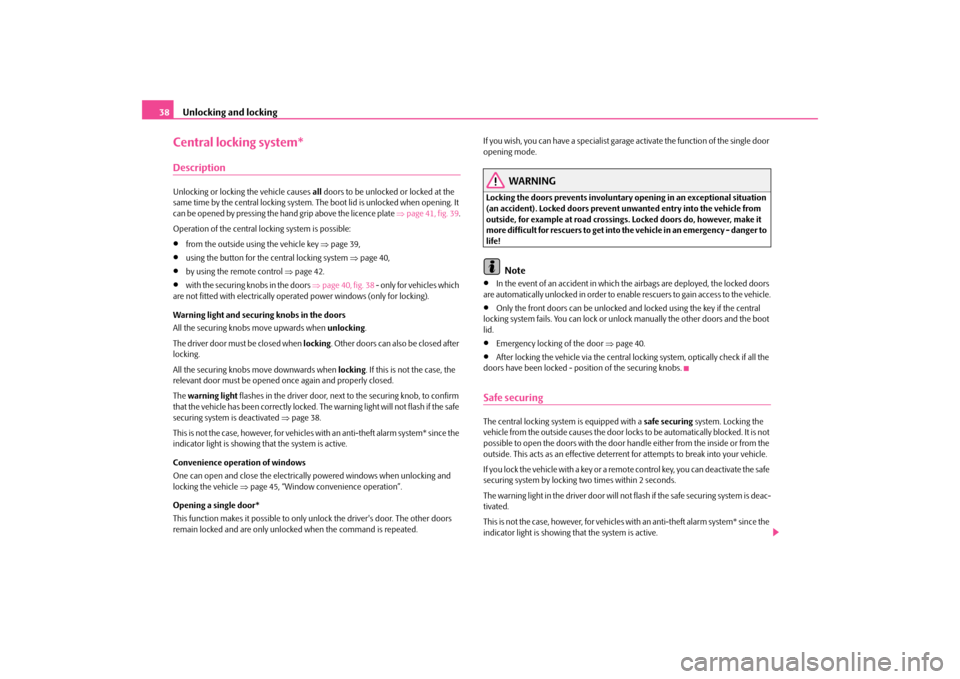
Unlocking and locking
38
Central locking system*DescriptionUnlocking or locking the vehicle causes
all doors to be unlocked or locked at the
same time by the central locking system. The boot lid is unlocked when opening. It can be opened by pressing the hand grip above the licence plate
⇒page 41, fig. 39
.
Operation of the central locking system is possible:•
from the outside using the vehicle key
⇒page 39,
•
using the button for the central locking system
⇒page 40,
•
by using the remote control
⇒page 42.
•
with the securing knobs in the doors
⇒page 40, fig. 38
- only for vehicles which
are not fitted with electrically operated power windows (only for locking). Warning light and securing knobs in the doors All the securing knob
s move upwards when
unlocking
.
The driver door must be closed when
locking
. Other doors can also be closed after
locking. All the securing knobs move downwards when
locking
. If this is not the case, the
relevant door must be opened
once again and properly closed.
The
warning light
flashes in the driver door, next to the securing knob, to confirm
that the vehicle has been correctly locked.
The warning light will not flash if the safe
securing system is deactivated
⇒page 38.
This is not the case, however, for vehicles
with an anti-theft alarm system* since the
indicator light is showing that the system is active. Convenience operation of windows One can open and close the electrically
powered windows when unlocking and
locking the vehicle
⇒page 45, “Window convenience operation”.
Opening a single door* This function makes it possible to only unlock the driver's door. The other doors remain locked and are only unlock
ed when the command is repeated.
If you wish, you can have a specialist garage
activate the function of the single door
opening mode.
WARNING
Locking the doors prevents involuntary
opening in an exceptional situation
(an accident). Locked doors prevent unwanted entry into the vehicle from outside, for example at road crossings. Locked doors do, however, make it m ore difficult for rescuers to get into
the vehicle in an emergency - danger to
life!
Note
•
In the event of an accident in which the airbags are deployed, the locked doors
are automatically unlocked in order to enable
rescuers to gain access to the vehicle.
•
Only the front doors can be unlocked and locked using the key if the central
locking system fails. You can lock or unlo
ck manually the other doors and the boot
lid.•
Emergency locking of the door
⇒page 40.
•
After locking the vehicle via the central locking system, optically check if all the
doors have been locked - posi
tion of the securing knobs.
Safe securingThe central locking system is equipped with a
safe securing
system. Locking the
vehicle from the outside causes the door lock
s to be automatically
blocked. It is not
possible to open the doors with the door ha
ndle either from the inside or from the
outside. This acts as an effective deterrent for attempts to break into your vehicle. If you lock the vehicle with a key or a remo
te control key, you can deactivate the safe
securing system by locking
two times within 2 seconds.
The warning light in the driver door will not
flash if the safe securing system is deac-
tivated. This is not the case, however,
for vehicles with an anti-theft alarm system* since the
indicator light is showing that the system is active.
s2g8.b.book Page 38 Tuesday, April 7, 2009 8:53 AM
Page 42 of 224
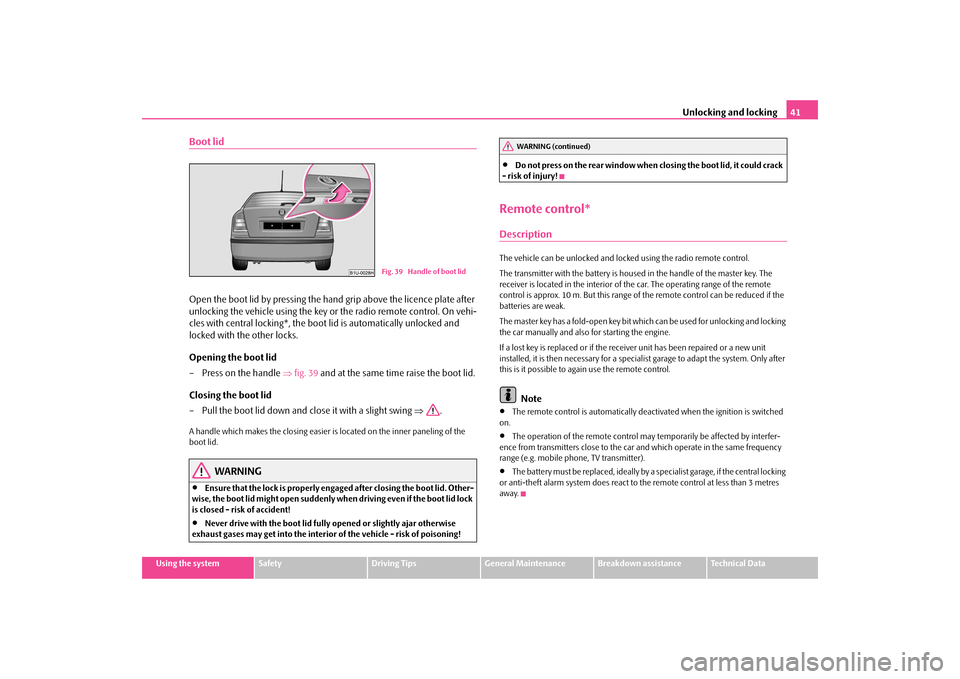
Unlocking and locking
41
Using the system
Safety
Driving Tips
General Maintenance
Breakdown assistance
Technical Data
Boot lidOpen the boot lid by pressing the ha
nd grip above the licence plate after
unlocking the vehicle using the key or the radio remote control. On vehi-cles with central locking*, the boot
lid is automatically unlocked and
locked with the other locks. Opening the boot lid – Press on the handle
⇒
fig. 39
and at the same time raise the boot lid.
Closing the boot lid – Pull the boot lid down and close it with a slight swing
⇒
.
A handle which makes the clos
ing easier is located on
the inner paneling of the
boot lid.
WARNING
•
Ensure that the lock is properly enga
ged after closing the boot lid. Other-
wise, the boot lid might open suddenly wh
en driving even if the boot lid lock
is closed - risk of accident!•
Never drive with the boot lid fully opened or slightly ajar otherwise
exhaust gases may get into the interior of the vehicle - risk of poisoning!
•
Do not press on the rear window when
closing the boot li
d, it could crack
- risk of injury!Remote control*DescriptionThe vehicle can be unlocked and locked using the radio remote control. The transmitter with the battery is housed
in the handle of the master key. The
receiver is located in the interior of th
e car. The operating range of the remote
control is approx. 10 m. But this range of
the remote control can be reduced if the
batteries are weak. The master key has a fold-open key bit whic
h can be used for unlocking and locking
the car manually and also for starting the engine. If a lost key is replaced or if the receiv
er unit has been repaired or a new unit
installed, it is then necessary for a specia
list garage to adapt the system. Only after
this is it possible to again use the remote control.
Note
•
The remote control is automatically deac
tivated when the ignition is switched
on.•
The operation of the remote control may temporarily be affected by interfer-
ence from transmitters close to the car and which operate in the same frequency range (e.g. mobile phone, TV transmitter).•
The battery must be replaced, ideally by a specialist garage, if the central locking
or anti-theft alarm system does react to
the remote control at less than 3 metres
away.
Fig. 39 Handle of boot lid
WARNING (continued)
s2g8.b.book Page 41 Tuesday, April 7, 2009 8:53 AM
Page 43 of 224
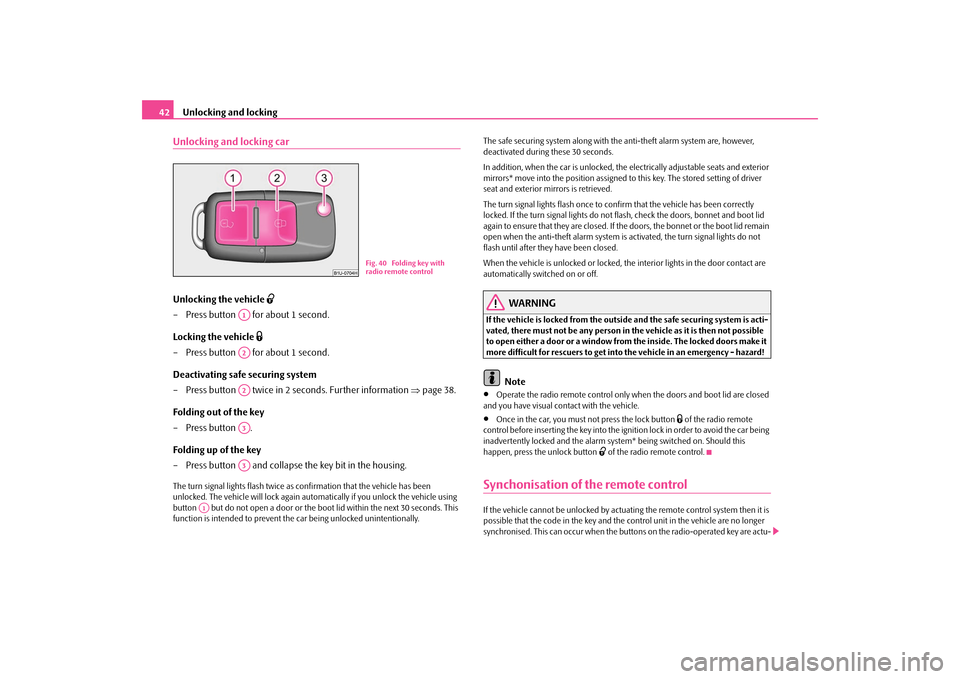
Unlocking and locking
42
Unlocking and locking carUnlocking the vehicle
– Press button for about 1 second. Locking the vehicle
– Press button for about 1 second.Deactivating safe securing system – Press button twice in 2 seconds. Further information
⇒
page 38.
Folding out of the key – Press button . Folding up of the key – Press button and collapse the key bit in the housing.The turn signal lights flash twice as
confirmation that the vehicle has been
unlocked. The vehicle will lock again auto
matically if you unlock the vehicle using
button but do not open a door or the
boot lid within the next 30 seconds. This
function is intended to prevent the car being unlocked unintentionally.
The safe securing system along with the anti-theft alarm system are, however, deactivated during these 30 seconds. In addition, when the car is unlocked, the el
ectrically adjustable seats and exterior
mirrors* move into the position assigned to this key. The stored setting of driver seat and exterior mirrors is retrieved. The turn signal lights flash once to co
nfirm that the vehicle has been correctly
locked. If the turn signal lights do not fl
ash, check the doors, bonnet and boot lid
again to ensure that they are closed. If th
e doors, the bonnet or the boot lid remain
open when the anti-theft alarm system is activated, the turn signal lights do not flash until after they have been closed. When the vehicle is unlocked or locked, the
interior lights in the door contact are
automatically switched on or off.
WARNING
If the vehicle is locked from the outsid
e and the safe securing system is acti-
vated, there must not be any person in the vehicle as it is then not possible to open either a door or a window from the inside. The locked doors make it more difficult for rescuers to get into
the vehicle in an emergency - hazard!
Note
•
Operate the radio remote control only when the doors and boot lid are closed
and you have visual co
ntact with the vehicle.
•
Once in the car, you must
not press the lock button
of the radio remote
control before inserting the key into the ignition lock in order to avoid the car being inadvertently locked and the alarm syst
em* being switched on. Should this
happen, press the unlock button
of the radio remote control.
Synchonisation of the remote controlIf the vehicle cannot be unlocked by actuatin
g the remote control system then it is
possible that the code in the key and the
control unit in the vehicle are no longer
synchronised. This can occur when the buttons on the radio-operated key are actu-
Fig. 40 Folding key with radio remote control
A1A2A2A3A3
A1
s2g8.b.book Page 42 Tuesday, April 7, 2009 8:53 AM
Page 44 of 224
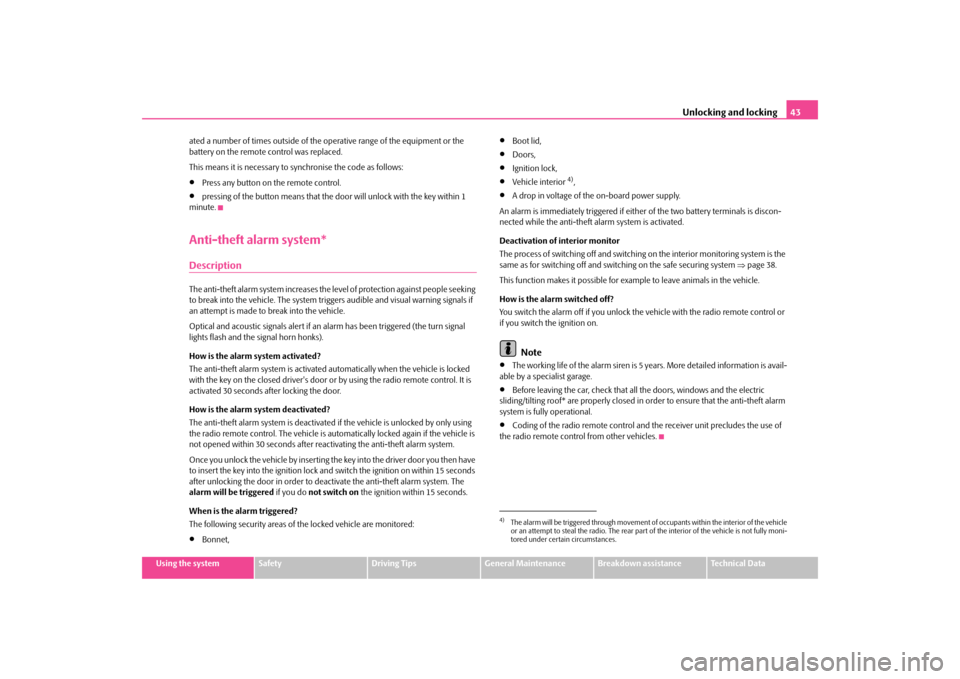
Unlocking and locking
43
Using the system
Safety
Driving Tips
General Maintenance
Breakdown assistance
Technical Data
ated a number of times outside of the operative range of the equipment or the battery on the remote control was replaced. This means it is necessary to synchronise the code as follows:•
Press any button on the remote control.
•
pressing of the button means that the door will unlock with the key within 1
minute.Anti-theft alarm system*DescriptionThe anti-theft alarm system increases the le
vel of protection against people seeking
to break into the vehicle. The system tri
ggers audible and visual warning signals if
an attempt is made to break into the vehicle. Optical and acoustic signals alert if an al
arm has been triggered (the turn signal
lights flash and the signal horn honks). How is the alarm system activated? The anti-theft alarm system is activated
automatically when th
e vehicle is locked
with the key on the closed driver's door or
by using the radio remote control. It is
activated 30 seconds after locking the door. How is the alarm system deactivated? The anti-theft alarm system is deactivated
if the vehicle is unlocked by only using
the radio remote control. The vehicle is au
tomatically locked agai
n if the vehicle is
not opened within 30 seconds after reac
tivating the anti-theft alarm system.
Once you unlock the vehicle by inserting the key into the driver door you then have to insert the key into the ignition lock an
d switch the ignition on within 15 seconds
after unlocking the door in order to deac
tivate the anti-theft alarm system. The
alarm will be triggered
if you do
not switch on
the ignition within 15 seconds.
When is the alarm triggered? The following security areas of the locked vehicle are monitored:•
Bonnet,
•
Boot lid,
•
Doors,
•
Ignition lock,
•
Vehicle interior
4),
•
A drop in voltage of the on-board power supply.
An alarm is immediately triggered if either of the two battery terminals is discon- nected while the anti-theft
alarm system is activated.
Deactivation of interior monitor The process of switching off and switching on the interior monitoring system is the same as for switching off and switching on the safe securing system
⇒page 38.
This function makes it possible for example to leave animals in the vehicle. How is the alarm switched off? You switch the alarm off if you unlock the
vehicle with the radio remote control or
if you switch the ignition on.
Note
•
The working life of the alarm siren is 5 years. More detailed information is avail-
able by a specialist garage.•
Before leaving the car, check that all the doors, windows and the electric
sliding/tilting roof* are properly closed in order to ensure that the anti-theft alarm system is fully operational.•
Coding of the radio remote control and
the receiver unit precludes the use of
the radio remote control from other vehicles.4)The alarm will be triggered through movement of
occupants within the interior of the vehicle
or an attempt to steal the radio. The rear part of the interior of the vehicle is not fully moni-tored under certain circumstances.
s2g8.b.book Page 43 Tuesday, April 7, 2009 8:53 AM
Page 64 of 224
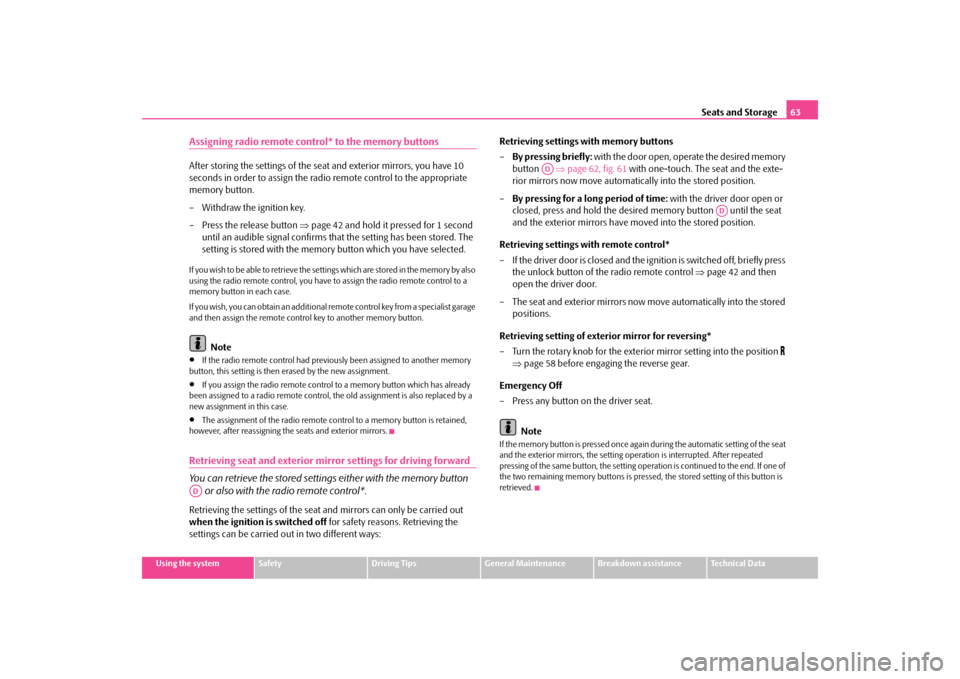
Seats and Storage
63
Using the system
Safety
Driving Tips
General Maintenance
Breakdown assistance
Technical Data
Assigning radio remote control* to the memory buttonsAfter storing the settings of the seat
and exterior mirrors, you have 10
seconds in order to assign the radio remote control to the appropriate memory button. – Withdraw the ignition key. – Press the release button
⇒
page 42 and hold it pressed for 1 second
until an audible signal confirms that the setting has been stored. The setting is stored with the memory button which you have selected.
If you wish to be able to retrieve the settings which are stored in the memory by also using the radio remote control, you have
to assign the radio remote control to a
memory button in each case. If you wish, you can obtain an additional re
mote control key from a specialist garage
and then assign the remote control key to another memory button.
Note
•
If the radio remote control had previous
ly been assigned to another memory
button, this setting is then erased by the new assignment.•
If you assign the radio remote control
to a memory button which has already
been assigned to a radio remote control,
the old assignment is also replaced by a
new assignment in this case.•
The assignment of the radio remote control to a memory button is retained,
however, after reassigning the seats and exterior mirrors.Retrieving seat and exterior mirror settings for driving forward You can retrieve the stored settings
either with the memory button
or also with the radio remote control*.
Retrieving the settings of the seat and mirrors can only be carried out when the ignition is switched off
for safety reasons. Retrieving the
settings can be carried out in two different ways:
Retrieving settings with memory buttons –
By pressing briefly:
with the door open, operate the desired memory
button
⇒
page 62, fig. 61
with one-touch. The seat and the exte-
rior mirrors now move automatically into the stored position.
–
By pressing for a long period of time:
with the driver door open or
closed, press and hold the desired memory button until the seat and the exterior mirrors have moved into the stored position.
Retrieving settings with remote control* – If the driver door is closed and the ignition is switched off, briefly press
the unlock button of the radio remote control
⇒
page 42 and then
open the driver door.
– The seat and exterior mirrors now
move automatically into the stored
positions.
Retrieving setting of exterior mirror for reversing* – Turn the rotary knob for the exterior mirror setting into the position
⇒
page 58 before engaging the reverse gear.
Emergency Off – Press any button on the driver seat.
Note
If the memory button is pressed once again
during the automatic setting of the seat
and the exterior mirrors, the setting operation is interrupted. After repeated pressing of the same button, the setting operation is continued to the end. If one of the two remaining memory buttons is pressed, the stored setting of this button is retrieved.
AD
AD
AD
s2g8.b.book Page 63 Tuesday, April 7, 2009 8:53 AM
Page 218 of 224
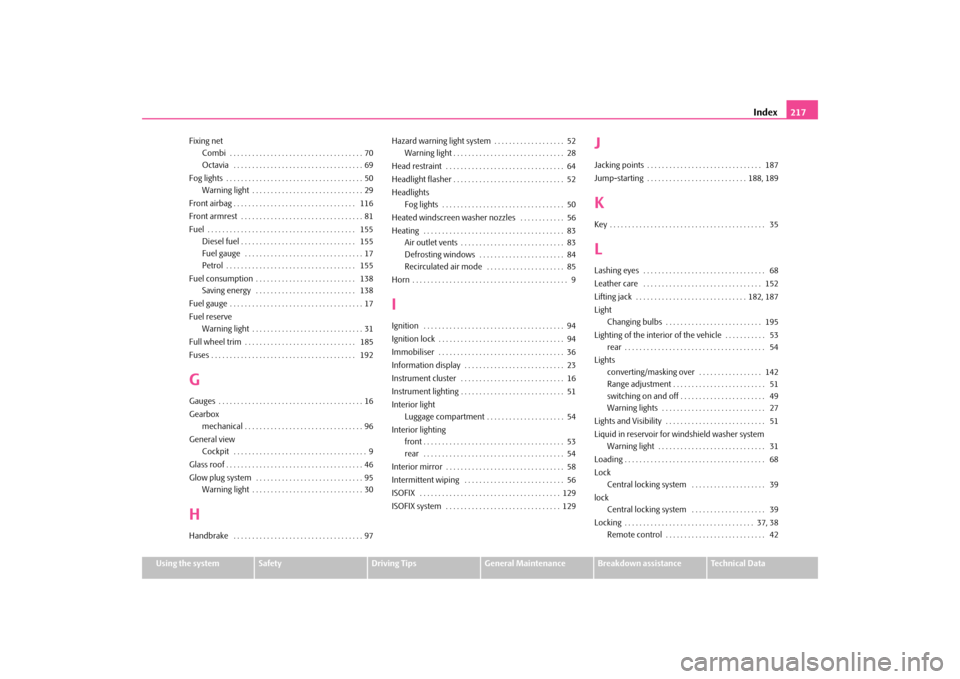
Index
217
Using the system
Safety
Driving Tips
General Maintenance
Breakdown assistance
Technical Data
Fixing net
Combi . . . . . . . . . . . . . . . . . . . . . . . . . . . . . . . . . . . . 70Octavia . . . . . . . . . . . . . . . . . . . . . . . . . . . . . . . . . . . 69
Fog lights . . . . . . . . . . . . . . . . . . . . . . . . . . . . . . . . . . . . . 50
Warning light . . . . . . . . . . . . . . . . . . . . . . . . . . . . . . 29
Front airbag . . . . . . . . . . . . . . . . . . . . . . . . . . . . . . . . . 116 Front armrest . . . . . . . . . . . . . . . . . . . . . . . . . . . . . . . . . 81 Fuel . . . . . . . . . . . . . . . . . . . . . . . . . . . . . . . . . . . . . . . . 155
Diesel fuel . . . . . . . . . . . . . . . . . . . . . . . . . . . . . . . 155Fuel gauge . . . . . . . . . . . . . . . . . . . . . . . . . . . . . . . . 17Petrol . . . . . . . . . . . . . . . . . . . . . . . . . . . . . . . . . . . 155
Fuel consumption . . . . . . . . . . . . . . . . . . . . . . . . . . . 138
Saving energy . . . . . . . . . . . . . . . . . . . . . . . . . . . 138
Fuel gauge . . . . . . . . . . . . . . . . . . . . . . . . . . . . . . . . . . . . 17 Fuel reserve
Warning light . . . . . . . . . . . . . . . . . . . . . . . . . . . . . . 31
Full wheel trim . . . . . . . . . . . . . . . . . . . . . . . . . . . . . . 185 Fuses . . . . . . . . . . . . . . . . . . . . . . . . . . . . . . . . . . . . . . . 192GGauges . . . . . . . . . . . . . . . . . . . . . . . . . . . . . . . . . . . . . . . 16 Gearbox
mechanical . . . . . . . . . . . . . . . . . . . . . . . . . . . . . . . . 96
General view
Cockpit . . . . . . . . . . . . . . . . . . . . . . . . . . . . . . . . . . . . 9
Glass roof . . . . . . . . . . . . . . . . . . . . . . . . . . . . . . . . . . . . . 46 Glow plug system . . . . . . . . . . . . . . . . . . . . . . . . . . . . . 95
Warning light . . . . . . . . . . . . . . . . . . . . . . . . . . . . . . 30
HHandbrake . . . . . . . . . . . . . . . . . . . . . . . . . . . . . . . . . . . 97
Hazard warning light system . . . . . . . . . . . . . . . . . . . 52
Warning light . . . . . . . . . . . . . . . . . . . . . . . . . . . . . . 28
Head restraint . . . . . . . . . . . . . . . . . . . . . . . . . . . . . . . . 64Headlight flasher . . . . . . . . . . . . . . . . . . . . . . . . . . . . . . 52 Headlights
Fog lights . . . . . . . . . . . . . . . . . . . . . . . . . . . . . . . . . 50
Heated windscreen washer nozzles . . . . . . . . . . . . 56Heating . . . . . . . . . . . . . . . . . . . . . . . . . . . . . . . . . . . . . . 83
Air outlet vents . . . . . . . . . . . . . . . . . . . . . . . . . . . . 83Defrosting windows . . . . . . . . . . . . . . . . . . . . . . . 84Recirculated air mode . . . . . . . . . . . . . . . . . . . . . 85
Horn . . . . . . . . . . . . . . . . . . . . . . . . . . . . . . . . . . . . . . . . . . 9IIgnition . . . . . . . . . . . . . . . . . . . . . . . . . . . . . . . . . . . . . . 94 Ignition lock . . . . . . . . . . . . . . . . . . . . . . . . . . . . . . . . . . 94Immobiliser . . . . . . . . . . . . . . . . . . . . . . . . . . . . . . . . . . 36 Information display . . . . . . . . . . . . . . . . . . . . . . . . . . . 23 Instrument cluster . . . . . . . . . . . . . . . . . . . . . . . . . . . . 16Instrument lighting . . . . . . . . . . . . . . . . . . . . . . . . . . . . 51 Interior light
Luggage compartment . . . . . . . . . . . . . . . . . . . . . 54
Interior lighting
front . . . . . . . . . . . . . . . . . . . . . . . . . . . . . . . . . . . . . . 53rear . . . . . . . . . . . . . . . . . . . . . . . . . . . . . . . . . . . . . . 54
Interior mirror . . . . . . . . . . . . . . . . . . . . . . . . . . . . . . . . 58 Intermittent wiping . . . . . . . . . . . . . . . . . . . . . . . . . . . 56 ISOFIX . . . . . . . . . . . . . . . . . . . . . . . . . . . . . . . . . . . . . . 129ISOFIX system . . . . . . . . . . . . . . . . . . . . . . . . . . . . . . . 129
JJacking points . . . . . . . . . . . . . . . . . . . . . . . . . . . . . . . 187Jump-starting . . . . . . . . . . . . . . . . . . . . . . . . . . . 188, 189KKey . . . . . . . . . . . . . . . . . . . . . . . . . . . . . . . . . . . . . . . . . . 35LLashing eyes . . . . . . . . . . . . . . . . . . . . . . . . . . . . . . . . . 68Leather care . . . . . . . . . . . . . . . . . . . . . . . . . . . . . . . . 152 Lifting jack . . . . . . . . . . . . . . . . . . . . . . . . . . . . . . 182, 187 Light
Changing bulbs . . . . . . . . . . . . . . . . . . . . . . . . . . 195
Lighting of the interior of the vehicle . . . . . . . . . . . 53
rear . . . . . . . . . . . . . . . . . . . . . . . . . . . . . . . . . . . . . . 54
Lights
converting/masking over . . . . . . . . . . . . . . . . . 142Range adjustment . . . . . . . . . . . . . . . . . . . . . . . . . 51switching on and off . . . . . . . . . . . . . . . . . . . . . . . 49Warning lights . . . . . . . . . . . . . . . . . . . . . . . . . . . . 27
Lights and Visibility . . . . . . . . . . . . . . . . . . . . . . . . . . . 51Liquid in reservoir for windshield washer system
Warning light . . . . . . . . . . . . . . . . . . . . . . . . . . . . . 31
Loading . . . . . . . . . . . . . . . . . . . . . . . . . . . . . . . . . . . . . . 68 Lock
Central locking system . . . . . . . . . . . . . . . . . . . . 39
lock
Central locking system . . . . . . . . . . . . . . . . . . . . 39
Locking . . . . . . . . . . . . . . . . . . . . . . . . . . . . . . . . . . . 37, 38
Remote control . . . . . . . . . . . . . . . . . . . . . . . . . . . 42
s2g8.b.book Page 217 Tuesday, April 7, 2009 8:53 AM